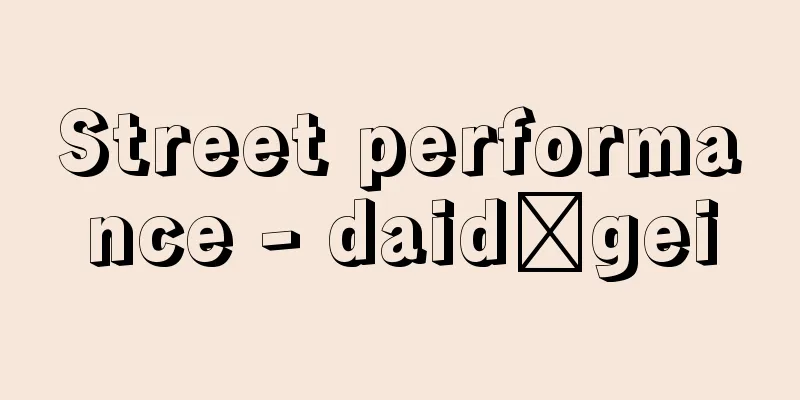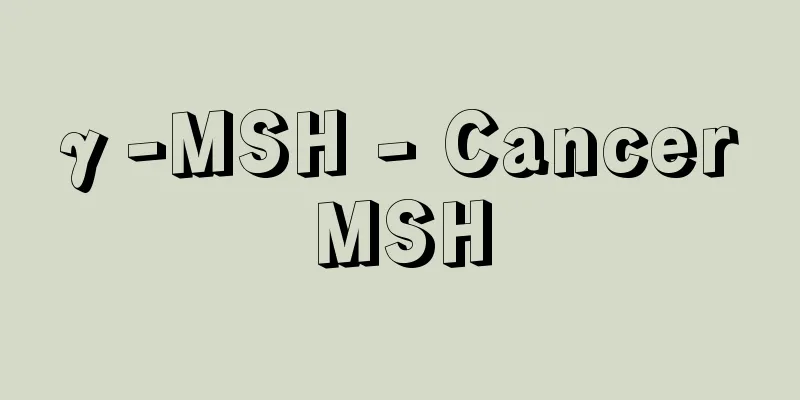Street performance - daidōgei

|
It is a general term for street entertainment in which performers perform in the open on the streets, in squares, and in entertainment districts, sometimes in temporary booths, and collect money from the crowds that have gathered, or sell goods while performing. In Japan, it is also called Tsuji-gei, as it is a performance held at the intersections of towns. When performers go to each household to perform, this is called Kadozuke-gei, and is generally distinguished from Daido-gei, but there are many forms in which the distinction is difficult to make, and some people consider Kadozuke-gei to be included in Daido-gei in the broad sense. Street performances, regardless of time or place, have created an unparalleled space for the people to release their energy on the streets, but since the performers are often nomadic people who are not taxed, and because they tend to be satirical or sarcastic towards the government or the dominant ideology of the time, there has been a history of repeated oppression and liberation. In the modern era, the streets and squares that made these street performances possible came under strict control, and street performances lost their power as the entertainment of the masses became indoors and non-communal. However, the modern bourgeois order system, which was clearly expressed in street control, began to be questioned worldwide, and it is noteworthy that the so-called "dissent" movements that swept through France, Japan and other countries in the late 1960s all adopted the slogan "reclaim the roads as playful "squares" as a form of expression. Taking advantage of this, new possibilities for various street performances, happenings and events have been explored in recent years, but the reality is that it is difficult to revive street performance that is full of folk vitality and is not exploited by commercial capital. Below, we will take a look at some representative street performances from different eras and regions. [Hiroshi Takayama] EuropeStreet performances already existed in ancient Egypt, Greece, and Rome. The custom of a troupe of acrobats, magicians, clowns, and actors going around places where people gather, such as fairs and festivals, was common throughout the ancient world. These unknown male and female entertainers would perform wherever and whenever someone would give them money. In particular, mimos (mimicry), performed by people who excelled in imitating things like the neighing of horses and the sound of thunder, were famous in Greece. It is known that the mimos acts performed by these street performers on floats were already popular in the early 5th century BC, and that this had an influence on the full-scale Greek theater that flourished in Athens (Athena) at around the same time. Mimus entered ancient Rome, where it was called Mimus, but even in ancient Rome, a city marked by war and cultural decadence, a unique culture of street performance unfolded against the backdrop of an increase in refugees due to war and the popularity of exoticism due to the expansion of the empire. Film director F. Fellini, who was interested in the world of street performance and had already captured the pathos of street performers on the silver screen in "La Strada," beautifully portrayed the flourishing of street performance culture at the end of the Roman Empire in films such as "Satyricon" and "Amarcord." Fights in the arena were exchanged for the lives of gladiators and animals, and even the freaks (deformed performers) that nobles kept in their mansions had to go out on the streets to beg if they lost favor. These ancient street arts flowed into the medieval arts. The legacy of these arts includes so-called folk theatre, such as masked pantomimes called mummery and sword plays. In medieval Europe, the activities of traveling street performers called gleemen were famous, and they were troupes of actors, singers, acrobats and animal handlers who performed while moving around. There were also jongleurs, who were distinguished from minstrels, the court minstrels, and from the 14th century onwards, this came to refer to almost all light entertainment. The singing and dancing of the Roma (formerly called gypsies), who appeared in Western Europe in the 15th century, also became an indispensable part of street performances. The wars of the 16th century also created the perfect conditions for the popularity of street performance, due to the increase in refugees and dissatisfaction with the authorities. For example, broadsides, a form of pop song reading, became popular in England from the 16th to the 17th century. Political and religious satirical songs were sold on the streets for one or two pence, printed on woodblocks. The Elizabethan authorities tried to suppress this on the pretext of keeping out vagrants. At the time, Bankside on the banks of the Thames in London was a mecca for street performance, where cruel animal shows such as bullfighting and bear-baiting, old impersonations, May games, Morris dances, sword plays and other old popular street performances continued to exist, competing with and influencing each other's performances at permanent theaters. Street performance would not have been able to flourish without the fairs that developed in England and France from the 12th century onwards. In England, Bartholomew's Fair in London was the most famous, and the sight of various vendors performing there is vividly depicted in Ben Jonson's classic comedy, Bartholomew's Fair (1614). However, the greatest center of modern street performance was Paris on the eve of the Revolution (1789), where street singers who sang and sold popular songs satirizing social ills such as the court and heavy taxes, street peddlers called charlatans who mainly sold dubious medicines, and acrobats called bateleurs gathered around the Pont Neuf bridge built by Henry IV. Also, in the two districts of Saint-Germain and Saint-Laurent, temporary booth theaters were performed and became very popular. These fair theaters (Théâtre de Foire) became a major threat to permanent theaters such as the Comédie-Française, which led to their suppression in the late 18th century, and after many twists and turns, their power was absorbed and integrated into theatrical entertainment. However, this street theater, known as opera comique, which was a descendant of the Italian commedia dell'arte, a masked comedy improvisation, brought together a diverse repertoire of street performances in its surroundings, including acrobatics, puppet shows, rare animal shows, freak shows, and optical mechanical shows such as portable magic lanterns, creating a powerful and vulgar space that could be called the final pole of what M. M. Bakhtin called "the culture of the square," and which expressed the growing popular vitality that was building up towards the great revolution. The depression in the early 20th century gave rise to unemployed street musicians, but today street musicians collectively known as buskers can be found in European and American cities, performing for money by singing and playing guitar or wind instruments around theaters and subway stations. [Hiroshi Takayama] JapanAs far back as the Nara period, there was a form of acrobatics called sangaku, which was introduced from the continent, and in the 8th century, when it ceased to be a form of entertainment for the imperial court and spread to the general public, the history of street performing arts in Japan began. Groups of performers called sanjomin or shomonshi, and refugee groups such as kugutsu (puppeteers), supported this, and in the Middle Ages, acrobatics such as kanjin bhikuni, kugutsu, hoka, gomune, kadozekkyo, and goze were performed, but it was during the Edo period, when urban culture developed and the streets were filled with people, that the astonishing diversification of street performing arts was seen. During the Genroku period (1688-1704), performances such as street imitations of Kabuki, Saruwaka, and Kubuki-shibai (head-up theater) emerged, and the cultural center eventually shifted east to Edo. With the development of the Edo local economic sphere and an increase in the number of wandering people, the Bunka and Bunsei periods (1804-1830) saw the emergence of a golden age of street performance that could rival that of 18th century Paris. The variety of dances increased dramatically to well over 300 types, including Sekizoro (Seasonal Seasons), Senzumanzai (Lion Dance), Harukoma (Harukoma), Lion Dance, Daikoku Dance, Torioi (Bird Chaser), Monkey Show, Puppet Show, Daikagura (Daikagura), Picture Explanations, Kado Dangi (Gate Discussion), Reading of the Taiheiki, Kowairo (Vocal Variety), Hitorizumou (Solo Sumo), Iainuki (Iaido), Kyokugoma (Curved Top), and Kyokumari (Curved Ball), and gave rise to street performance meccas such as Ueno Yamashita and Asakusa Okuyama. Street performers, whether in the East or the West, tend to be visually indulgent, and in the late Edo period, optical entertainment such as rare animal and freak shows and peep tricks also increased. There were also many street peddlers, who attracted customers with sword-drawing and spinning tops, and sold ointments and toothpaste. These peddlers ran their businesses under the command of the head of the outcasts, Yano Danzaemon, and his subordinates, Gomune Nidayu, and Kuruma Zenshichi. In addition to medicine, candy peddlers also performed songs, dances, and vocalizations to attract customers. From the end of the Edo period to the Meiji period, the repertoire was expanded to include sand paintings, sand letters, famous place paintings, honihoro, benikan, magic tricks, Nekohachi, snake charmers, kappore, deroren saibun, and strong men. Also, from the lineage of street performances called nagashi, such as koiroya and shinnai nagashi, came the enka singers and hokai performers of the Meiji period, which are connected to the traveling guitarists seen in restaurants in recent years. Street performances in Japan are thought to have ended at the end of the Meiji period. Even the chindon performers, which are descended from the hachiningei, and the kamishibai, which are descended from the puppeteers, are rarely seen these days. [Hiroshi Takayama] AsiaThe history of street performance is also ancient in China, and is said to have originated when priests known as shamans became corrupt and became traveling performers. It became widespread as entertainment for the masses during the Northern Song Dynasty. Before the revolution, various street performances were held all over the country, centering on the tradition of Sangaku, which included repertoires such as ballads and tightrope walking. Popular street performances included storytelling such as kodan (storytelling), singing arts such as drumming, swordplay, ballads, magic tricks, animal arts such as monkey trolling and mouse taming, puppetry, and shadow play. Even after the revolution, these street arts continued to be valued by the government as entertainment for the masses, and the traditions of Chinese street performance are now often carried on in circuses. The influence of Chinese street arts gave birth to Korean street performances, especially the singing arts such as Changjuku and Pansori. Koreans boast a repertoire that includes masked plays such as Bongsan-taal, sword dances, and nine drum dances, but the Namsadang group of street performers who roamed the peninsula during the Yi Dynasty period and performed masked plays, puppet shows, acrobatics, and tightrope walking deserves special mention. Although it died out during the Japanese colonial period, in recent years, in response to a movement in Korea to turn its attention to its own folk arts, its style has been revived in the performances of percussion groups such as Samulnori. Indonesia, especially Java and Bali, is now the center of street performance in Asia. Wayang, a street performance accompanied by gamelan music, is particularly famous. There are about six types of wayang, including puppet theater, shadow puppet theater, and masked theater, and it is recognized that wayang embodies the fundamental vitality of the people that has been lost in street performances in many parts of the world. It has been a great source of inspiration for theater artists such as Antonin Artaud who have tried to revive this folk vitality in 20th century theater. [Hiroshi Takayama] Street performance and modern societyLooking at the repertoires of street performances in the above-mentioned regions, it can be said that these street performers were literally carrying the culture of the "square" that Bakhtin described in the world of the popular comic writer Francois Rabelais in the early modern period, in the squares and on the streets. In the second half of the 18th century, the city space became deserted and street performances were "indoorized" into theaters, but the culture of the square is a cultural model that should be clearly confronted with modern culture, which places intellect and rationality at the center of human activity, values individualism, and is indoors, and is a culture that aims to communicate with each other through the body that every human being has. The (especially acrobatic) stunts of street performers, who literally put their bodies on the line and use their voices, are thorough physical arts, and the speeches of the performers, full of language play, free the physicality of language (associativeness, playfulness) from the burden of meaning. In this way, the world of street performance demonstrates the richness and vulgarity of "corporeality" at every level that we, as individuals and as a community that is the collection of individuals, should possess but that we have discarded in the name of rationality. During the 19th century, both Europe and Japan lost street performance almost completely, which was the moment when bourgeois civil society completed the construction of the streets in the name of modernization and rationalization. For example, with Baron Haussmann's remodeling of the city of Paris (after 1853), the space for street performance that had gathered around the Pont Neuf and the city (Foir) disappeared. Today, only buskers and pavement painters can be seen on the streets. The decline of street performance clearly shows the lonely indoor state of our culture, which is losing its "square" and places for lively communication. [Hiroshi Takayama] "A Study of Spectacles" by Asakura Musei (1928, Shunyodo)" ▽ "A History of the Performing Arts and Customs of the Common People's Streets of Edo" by Miyao Shigeo and Kimura Senshu (1979, Tenbosha)" ▽ "The Works of François Rabelais and the Popular Culture of the Middle Ages and Renaissance" by Mikhail Bakhtin, translated by Kawabata Kaori (1973, Serika Shobo) ▽ "Freaks" New Edition by Leslie Fiedler, translated by Ito Shunji and Oba Masaaki (1999, Seidosha) " ▽ "The Dramaturgy of the Demon" by Jackson Cope, translated by Takayama Hiroshi and Hamana Emi (1986, Arina Shobo) [References] | | |Masquerade| | | | | | | | | | | |Wearing eboshi hats and carrying bamboo poles with short poems hanging from them, they walk around singing short poems while beating a tsukuko. "Shokunin Utaawase Ehon" (Illustrated Book of Artisans' Poems), published in 1838 (Tenpo 9), owned by the National Diet Library . Let go "Jinrin Kunming Zui" Vol. 7, published in 1690 (Genroku 3), owned by the National Diet Library sermon Scroll. The first scroll (part) of the "Shokunin-zukushi Ekotoba" (Illustrated Tales of Artisans). The original is by Kuwagata Keisai (Kitao Masami), and is housed in the Sankyo Denkotoba (Courtesy of the National Diet Library ) Seasons Banzai. "Shokunin-zukushi Ekotoba" (Artisans' Ekotoba), first scroll (part) The original is by Kuwagata Keisai (Kitao Masami), and the Sankyo Denkotoba ( Courtesy of the National Diet Library ) Hurrah Copy of "Yuzu Nembutsu Engi" published during the Kyowa period (1801-1804) Owned by the National Diet Library Medieval monkey trainer Daikagura. First scroll (part) of "Shokunin-zukushi Ekotoba" (Artisan's Tale). The original is by Kuwagata Keisai (Kitao Masami), and is housed in the Sankyo Denkotoba (National Diet Library ). Daikagura (acrobatics) Source: Shogakukan Encyclopedia Nipponica About Encyclopedia Nipponica Information | Legend |
|
街頭、広場、盛り場などにおいて、まったくの野天で、ときには仮設の掛け小屋(ブース)で、芸を見せ、集まった群集から銭を集めたり、その芸を見せながら商品を売る巷間(こうかん)芸能を総称していう。町辻(まちつじ)で行うパフォーマンスperformanceということから、日本では辻芸とも称される。芸を行う者のほうから各戸を訪れてきて芸を見せるのを門付(かどづけ)芸と称して、いちおうは大道芸と区別されるが、なかには区別がつかない形態のものも多く、門付芸も広義の大道芸に含むとみる見方もある。 大道芸は、古今東西を問わず、民衆的活力を街頭に発散させるこのうえない空間をつくりだしたが、担い手が租税負担を負わぬ流浪の人々であることが多く、いきおい為政者側への、あるいは時代の支配的イデオロギーへの風刺や揶揄(やゆ)の色彩が強くなりがちなこともあって、弾圧と解放の歴史を繰り返した。やがて近代になると、こうしたストリート・パフォーマンスを成り立たせていた街頭や広場そのものが強力な管理を受け、また大衆の娯楽が室内(インドア)化し、非共同体化していく趨勢(すうせい)に押される形で大道芸は力を失っていった。しかし、街頭管理に端的に表れた近代ブルジョアジー的秩序体系が世界的に疑問視され始め、1960年代後半フランス、日本をはじめ各国に巻き起こったいわゆる「異議申し立て」運動が、そろって、その表現の一形式として、道路を遊戯性に満ちた「広場」として奪回せよというスローガンを掲げたことは特筆される。それを契機に街頭におけるさまざまなパフォーマンス、ハプニングhappeningやイベントeventの可能性が近年新たに模索されつつあるが、商業資本の側に利用されることのない、民衆的活力に満ちた大道芸の復活はなかなか困難というのが現状である。以下、代表的な時代と地域の大道芸を概観してみよう。 [高山 宏] ヨーロッパ街頭を舞台とする大道芸はすでに古代、エジプトやギリシア、ローマに存在した。軽業(かるわざ)師、手品師、道化、役者などが一座をなして、市(いち)や祭礼など人々の集まる場所を巡り歩く習俗が古代世界全般に存在している。これら名も知れぬ男女芸人は、彼らに金銭を与える者がいれば、どこででも、いつでも芸を見せた。とくにギリシアで馬のいななきや雷の音などの物真似(ものまね)に長じた者たちのミモスmimos(物真似を中心とした雑芸(ぞうげい))が有名で、すでに紀元前5世紀初めにこうした大道芸人たちが山車(だし)の上で演じるミモス芸が人気を博していたこと、そしてこれがほぼ同時代のアテナイ(アテネ)に開花した本格的ギリシア演劇に影響を及ぼしていったことが知られている。このミモスは古代ローマに入り、ミムスmimusといわれたが、戦乱と文化的退廃を特徴とするその古代ローマも、一方で戦争による流民の増加、帝国版図の拡大による異国趣味の流行などを背景に、独特な大道芸の一大文化を繰り広げた。大道芸の世界に関心をもち、すでに『道』で大道芸人のペーソスを銀幕に定着してみせた映画監督F・フェリーニが古代ローマに取材した『サテュリコン』『アマルコルド』などの画面に、ローマ帝国末期の大道芸文化の爛熟(らんじゅく)ぶりがみごとに活写されている。闘技場での闘技は剣闘士や動物の生命と引き換えのものであったし、貴族が邸(やしき)に抱えていたフリークスfreaks(異形の芸人)たちにしても、寵(ちょう)を失ったりすると街頭に立って物ごいをしなければならなかったのである。 これら古代の巷間芸能は中世の雑芸へと流れ込んだ。ママリーmummeryとよばれる仮面の無言劇や、ソード・プレイsword play(剣の舞)といった、いわゆる民衆劇などがその遺産である。ヨーロッパ中世では、グリーマンgleemanと称される遊行大道芸人たちの活躍が有名で、役者、歌手、曲芸師、動物使いたちが一座の形で移動しながら芸を見せた。また、ミンストレルminstrelとよばれる宮廷吟遊詩人たちと区別される放浪芸人ジョングルールjongleurたちがいて、14世紀以降これはほとんどの軽演芸を総称するものになっていく。15世紀に西ヨーロッパに姿を現したロマ(かつてはジプシーとよばれた)たちの歌舞も、大道芸の添景として欠かせぬものとなる。 16世紀の戦乱も、流民の増大、為政者への不満という大道芸の流行に格好の条件をつくりだし、たとえば16世紀から17世紀にかけてイギリスでブロードサイドbroadsideとよばれる流行歌の読み売りがはやった。政治・宗教への風刺歌が街頭で1ペニーか2ペンスかで木版刷りで売られたのである。エリザベス朝当局は浮浪者締め出しを口実にこれを弾圧しようとした。当時、ロンドンのテムズ川岸のバンクサイドは大道芸のメッカで、闘牛や熊(くま)いじめといった残酷な動物芸や、古い物真似芸、5月祭(メイ・ゲーム)、モリス・ダンスmorris dance、ソード・プレイなど古い大衆的大道芸が存続して、常設の劇場とせめぎ合い、互いに影響しあった。大道芸は、12世紀以降イギリスやフランスで発達した市(フェア)なくしては大発展はありえなかったのだが、イギリスではロンドンのバーソロミュー市(フェア)が有名で、そこに各種呼び売りが芸を披露するさまは、ベン・ジョンソンの名作喜劇『バーソロミュー市(フェア)』(1614)に生き生きと描かれている。 しかし、近代最大の大道芸の中心地は大革命(1789)前夜のパリであって、アンリ4世がつくった橋ポン・ヌフを中心に、宮廷や重税といった社会悪を風刺する流行歌を歌い、売る、読み売りの大道歌手や、おもに怪しげな薬を商うシャルラタンcharlatanとよばれる大道香具師(やし)、バトルールbateleurとよばれる曲芸師などが蝟集(いしゅう)した。またサン・ジェルマン、サン・ローランの二つの地区に立った市(フォアール)には仮設の掛け小屋(ブース)芝居がかかって大人気を博し、この縁日芝居(テアトル・ド・フォアール)はコメディ・フランセーズなど常設劇場への大きな脅威となったため、18世紀後半弾圧を招き、曲折のすえ、劇場芸能のなかへとそのパワーを吸収統合されていった。しかし、イタリアの大道即興仮面喜劇コメディア・デラルテに系譜するオペラ・コミックと称されたこの大道演劇は、その周辺にアクロバット芸、人形芝居、珍獣の見せ物、フリークス芸、そして携帯幻灯機といった光学機械興行など多彩な大道芸のレパートリーを結集させ、大革命に向けて増大していく民衆的活力の発露された、M・M・バフチンのいわゆる「広場の文化」の最後の極といえるパワフルで猥雑(わいざつ)な空間をつくりだした。 20世紀初頭の不況期には失業者の辻音楽師を生み出したが、現在ではバスカーbuskerと総称される、劇場周辺や地下鉄駅でギターの弾き語りや管楽器の演奏を聞かせて金をもらうストリート・ミュージシャンたちが、欧米の諸都市にみられる。 [高山 宏] 日本古くは奈良時代に大陸から伝来してきた散楽(さんがく)という曲芸があり、8世紀これが宮廷の戯芸でなくなり、民間に流れ出たとき、日本の大道芸能史は始まる。算所(さんじょ)民とか唱門師(しょうもんし)とかよばれる芸能者集団、くぐつ(傀儡子(かいらいし))など流民集団がこれを支え、中世には勧進比丘尼(びくに)、くぐつ、放下(ほうか)、乞胸(ごうむね)、門説経(かどぜっきょう)、瞽女(ごぜ)などの雑伎が行われたが、巷間芸の驚くべき多彩化は、都市文化が発達し、路上に人々があふれた江戸時代にこそみられる。元禄(げんろく)時代(1688~1704)には歌舞伎(かぶき)を街頭でまねする物真似、猿若(さるわか)、首かけ芝居といった芸が現れ、やがて文化の中心が江戸に東漸し、江戸地回り経済圏の発展による流浪民の増加を背景に、文化・文政(ぶんかぶんせい)時代(1804~1830)という、18世紀パリにも匹敵する大道芸の黄金時代が現出した。節季候(せきぞろ)、千秋万歳(せんずまんざい)、春駒(はるこま)、獅子舞(ししまい)、大黒舞(だいこくまい)、鳥追(とりお)い、猿回し、人形回し、太神楽(だいかぐら)、絵解き、門(かど)談義、太平記読み、声色(こわいろ)、独相撲(ひとりずもう)、居合抜き、曲独楽(きょくごま)、曲鞠(きょくまり)と、その種類も激増して優に300種を上回り、上野山下、浅草奥山など大道芸のメッカを生み出した。 洋の東西を問わず大道芸も視覚に淫(いん)する傾向があり、江戸末期には珍獣やフリークスの見せ物、のぞきからくりといった光学興行も増えた。大道香具師(やし)も多く、居合抜き、曲独楽で客寄せしておいて、膏薬(こうやく)や歯みがきなどを売った。非人頭(かしら)矢野弾左衛門とその配下、乞胸仁太夫(ごうむねにだゆう)、車善七(くるまぜんしち)の差配下に、これら香具師は業を営んだ。薬ばかりでなく飴(あめ)売り行商人たちも客寄せに歌舞、声音(こわね)を演じた。幕末から明治にかけて、砂絵、砂文字、名所絵かき、ほにほろ、紅勘(べにかん)、手品、猫八、蛇使い、かっぽれ、でろれん祭文、力持ちなど、さらにレパートリーが加わっていく。また声色屋、新内(しんない)流しなど流しとよばれた大道芸の系統から、明治の演歌師や法界(ほうかい)屋が出てくるが、これが近年の飲食店に姿をみる流しのギター弾きにまで連なっている。日本の大道芸は明治末年に終わったとみられる。八人芸に系譜するチンドン屋、人形回しの流れをくむ紙芝居さえもいまはほとんどみられなくなってしまった。 [高山 宏] アジア大道芸の歴史は中国においても古く、巫覡(ふげき)と称される聖職者が堕落して遊行芸人になったのがその起源といわれ、北宋(ほくそう)時代に民衆娯楽として流布した。弄玉(ろうぎょく)、綱渡りといったレパートリーを含む散楽の伝統を中心に、革命前まではさまざまな大道芸が各地で行われていた。評書(講談)といった語り物、鼓詞などの歌謡芸、弄剣、弄玉、手品、それに猿回し、ネズミ使いといった動物芸、傀儡戯、皮影戯が盛行した。これら大道の雑芸は革命後も民衆娯楽として政府から重要視されており、また中国大道芸の伝統はいまではサーカスのなかに多く受け継がれている。 中国巷間芸能の影響は朝鮮の大道芸、とくに、歌唱芸である唱劇、パンソリなどを生み出した。鳳山(ほうざん)タールといった仮面劇、剣舞、九鼓舞といったレパートリーを誇るが、李朝(りちょう)時代、半島を放浪して仮面劇、人形劇、アクロバットや綱渡りを見せた男寺党(ナムサダン)という大道芸人集団は特筆に値する。日本による支配時代に滅びてしまったが、近年になって韓国が民族芸能に目を向けるようになった動きに呼応して、サムルノリといったパーカッション・グループの演奏のなかにその芸風が復活した。 アジアの大道芸の中心はいまやインドネシア、とくにジャワ島とバリ島である。ガムラン音楽を伴うワヤンという大道芸がとりわけ有名である。人形芝居、影絵人形芝居、仮面劇など6種類ほどのワヤンがあるが、世界の多くの地域の大道芸が喪失してしまった民衆の根源的な活力がそこに認められ、アントナン・アルトーをはじめ20世紀演劇にそうした民衆的活力を復活させようとした演劇人たちの大きな霊感源となっている。 [高山 宏] 大道芸と近代社会以上のような地域のもろもろの大道芸のレパートリーを眺めてみると、近世初頭、民衆的滑稽(こっけい)作家フランソア・ラブレーの世界についてバフチンのいった「広場」の文化を、文字どおり広場で、街頭で担っていたのが、こうした大道芸人たちであったといえる。18世紀後半に市の空間がさびれ、大道芸は劇場へと「室内(インドア)化」されていったが、広場の文化とは、人間活動の中心を知性と合理に置き、個人主義をよしとして、室内化していく近代文化にはっきりと対峙(たいじ)されるべき文化モデルであり、人間だれしもがもっている肉体を通して互いにコミュニケートしあうことを目ざす文化なのである。文字どおり体を張り、声を出す大道芸の(とくにアクロバット的な)離れ技は徹底した肉体芸であり、また香具師たちの言語遊戯に満ちた口上は、言語の肉体性(連想性、遊戯性)を意味性の重荷から解き放つ。こうして個人として、またその個人の集合体である一共同体として、われわれがもっているはずなのに、合理の名の下に切り捨ててしまってきたあらゆるレベルにおける「肉体性」の豊穣(ほうじょう)と猥雑を、これら大道芸の世界は示している。 19世紀中に、ヨーロッパ、日本ともにほぼ完全に大道芸を失ったが、それこそは、ブルジョア市民社会が近代化、合理化の名の下に街路の整備を完了した瞬間のことであった。たとえばオスマン男爵によるパリ市改造(1853以降)をもって、ポン・ヌフと市(フォアール)に蝟集した大道芸の空間は消滅した。今日、大道にはバスカーたちと舗道画家をみるのみである。大道芸の衰退は、「広場」を失い、生き生きしたコミュニケーションの場を失いつつあるわれわれの文化の孤独な室内化の様相を如実に示すものなのである。 [高山 宏] 『朝倉無声著『見世物研究』(1928・春陽堂)』▽『宮尾しげを・木村仙秀著『江戸庶民街芸風俗誌』(1979・展望社)』▽『ミハイール・バフチーン著、川端香男里訳『フランソワ・ラブレーの作品と中世・ルネッサンスの民衆文化』(1973・せりか書房)』▽『レスリー・フィードラー著、伊藤俊治・大場正明訳『フリークス』新版(1999・青土社)』▽『ジャクソン・コープ著、高山宏・浜名恵美訳『〈魔〉のドラマトゥルギー』(1986・ありな書房)』 [参照項目] | | | | | | | | | | | | | | |烏帽子姿で短冊を吊り下げた笹竹を背負い、筑子を打って小歌をうたい歩く。『職人歌合画本』 1838年(天保9)刊国立国会図書館所蔵"> 放下 『人倫訓蒙図彙』 7巻 1690年(元禄3)刊国立国会図書館所蔵"> 門説経 せきぞろ。『職人尽絵詞』 第1軸(部分) 原図は、鍬形蕙斎(北尾政美)画、山東京伝詞書国立国会図書館所蔵"> 節季候 万才。『職人尽絵詞』 第1軸(部分) 原図は、鍬形蕙斎(北尾政美)画、山東京伝詞書国立国会図書館所蔵"> 万歳 『融通念仏縁起』 写 享和年間(1801~1804)刊国立国会図書館所蔵"> 中世の猿回し 太神楽。『職人尽絵詞』 第1軸(部分) 原図は、鍬形蕙斎(北尾政美)画、山東京伝詞書国立国会図書館所蔵"> 太神楽(曲芸) 出典 小学館 日本大百科全書(ニッポニカ)日本大百科全書(ニッポニカ)について 情報 | 凡例 |
<<: Daedong River - Daedong River
Recommend
"The Diary of Anne Frank"
…the girl known for the so-called “Diary of Anne ...
Chicago Board of Trade
The first grain futures exchange in the United Sta...
Tonic labyrinth reflex - Tonic labyrinth reflex
…This is a flexion reflex, in which when one leg ...
Study book - Study book
[1] [noun] A book or document on music. ※Shiji Sho...
Food problem - Shokuryo Mondai
The food problem is usually thought of as a food s...
Yellow egg wasp - Yellow egg wasp
...They prefer wet grasslands such as rice paddie...
Yeonpyeong Island
The two islands of Daeyeongpyeong Island and Soyou...
Master craftsman
A carpenter with excellent skills. A skilled craft...
Haute-Volta (English spelling)
The former name of Burkina Faso, a landlocked cou...
Sinn Fein
A political group that promoted the Irish independ...
Loofah flower - Loofah flower
A monthly magazine launched by Baibunsha in Januar...
Kichizo Ishida
…On May 18, 1936, Kichizo Ishida, who ran a small...
Hemigalus (English spelling)
A general term for a mammal of the Hemigalinae sub...
Rosselli, Cosimo
Born: 1439. Florence Died January 7, 1507. Italian...
Es Saheri (English spelling)
...Mali declined as the Songhai people in the eas...









